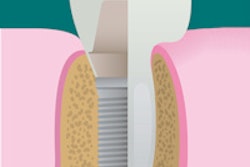A new type of implant can benefit a wider range of patients, including those with degeneration of bone in the upper or lower mandible, according to a study in the Journal of Oral Implantology (June 2013, Vol. 39:3, pp. 314-325).
Researchers from Cleveland ClearChoice Dental Implant Center analyzed the all-on-four treatment used with the NobelActive implant (Nobel Biocare). Follow-up evaluations of 227 implants from one to three years after the procedure show a 98.7% implant survival rate, the study authors found.
In the all-on-four concept, four implants are used to support an acrylic, screw-retained provisional prosthesis, then a final prosthesis about four months later. Although this method uses only four implants, two of them are placed distally tilted in areas where bone height, nerve proximity, or other conditions make it impossible to place the implant axially. This tilting allows the placement of longer implants that have good anchorage in the best positions for prosthetic support.
Previously, standard practice called for dental implants of at least 4.0 mm in diameter, according to the study authors. For tilted implants in particular, this was considered the smallest diameter that could guarantee sufficient anchorage. The NobelActive implant made it possible to use a 3.5-mm diameter implant for patients with atrophic jaws, the researchers found.
Featuring tapering, a variable thread, and an inward tapered collar, this implant offers self-drilling capacity and bone-compression qualities, they noted. High torque values can be reached, giving the implant high initial stability.
Prior studies have found that failed implants using the all-in-four method were a result of soft bone and lower insertion torque values, according to the study authors. The combination of a 3.5-mm diameter implant and the all-on-four technique brings new treatment possibilities to patients with severe bone deficiencies, they concluded.



















